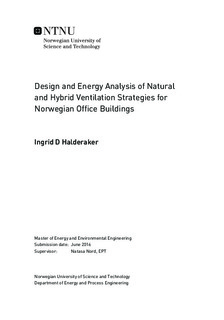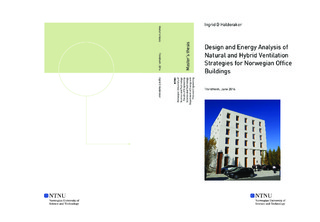| dc.description.abstract | Buildings lack of sufficient flexibility and generality leads to the need of comprehensive adjustments when new tenants are moving in. In addition, many building owners experience faults and problems with the operation of advanced technical installations. The challenges implies a potential to reduce costs and resources by creating more adaptable buildings and limit the complexity of the technical installations.
In this thesis, examples of integrated ventilation strategies have been investigated by the use of the dynamic simulation tool IDA ICE. The strategies were inspired by the building 2226 in Austria by Baumschlager Eberle, and are systems where natural and hybrid ventilation interact with the thermal properties of the construction through automatic windows. A manual window solution with a user app was designed to model stochastic human behavior. A series of simulations were performed to predict the indoor climate and energy use of the integrated ventilation strategies in Norwegian conditions.
According to the results, all scenarios with automatic windows can provide satisfactory thermal conditions during spring, summer and autumn. The combination of night cooling and exposed thermal mass limits problems with overheating in summer, and gives a maximum temperature of 27°C with the given conditions. The main challenge, particularly with solely natural ventilation, is to provide thermal comfort during window airing in winter. In the naturally ventilated scenario, the temperature momentary drops down to 15°C on the coldest day. Results show that a hybrid strategy can provide a better indoor climate in winter, by limiting the number of pulse ventilations needed on cold days, and generally increasing the indoor temperature. The demand-controlled natural ventilation ensures satisfactory CO2-levels of maximum 1100 ppm in all scenarios. Due to the required calculation method in NS 3031, buildings with only natural ventilation cannot fulfill the energy requirements in TEK. However, simulations results show a low energy use of 63 kWh/m2 for a naturally ventilated and 54 kWh/m2 for two hybrid ventilated scenarios. Furthermore, the naturally ventilated scenario is found to have a need for heating, while the need of and size of suitable heating systems for the hybrid strategies can be discussed.
The use of stochastic variables in building simulation is a suitable procedure to model different outcomes of human behavior. The design of a manual window control based on stochastic variables was however not successful in this thesis. Thus, further work is needed to develop a suitable simulation model in IDA ICE of occupant behavior with stimuli from an app.
Passive design strategies and the use of hybrid ventilation are shown to be promising tools to obtain a more sustainable building design with low life cycle costs, low energy use and a good indoor climate. The use of hybrid ventilation systems requires a different approach than conventional mechanical systems. It is crucial that conditions for natural ventilation and passive cooling are present. Furthermore, the system must be well controlled and integrated in the building design. The building s context, function, geometry, users, components and floor plans determines the feasibility of solutions and must be thoroughly assessed in every case. | |

